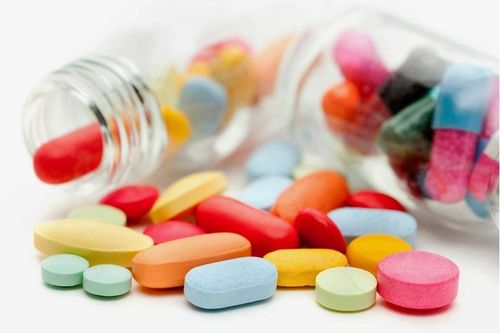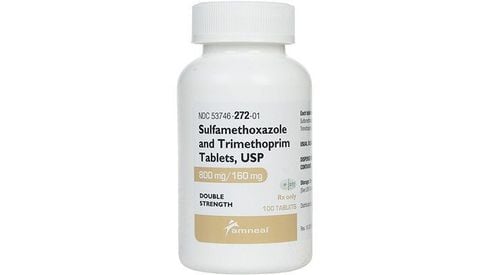This is an automatically translated article.
Statalli drug has the main active ingredient Cephradin 500mg and other excipients in sufficient quantity. Statalli belongs to the group of antibiotics with anti-parasitic, anti-infective, antiviral and antifungal effects.
1. What is Statalli?
Statalli drug has the main active ingredient Cephradine with the strength of 500mg and other excipients in sufficient quantity. This is an antibiotic with anti-parasitic, anti-bacterial, anti-viral, and anti-fungal properties.
Statalli is made in the form of hard capsules, suitable for direct oral use. Packing is a box of 10 blisters, each blister contains 10 capsules.
Effect of active ingredient Cephradine:
Active ingredient Cephradine is a semi-synthetic cephalosporin antibiotic. Statalli has a bactericidal effect by inhibiting the synthesis of mucopeptides in the bacterial cell wall. The active ingredient Cephradine is active against many gram-positive bacteria including penicillinase-secreting or non-penicillinase-secreting Staphylococcus aureus, group A beta-hemolytic Streptococcus, group B Streptococcus and Streptococcus pneumoniae. Cephradine has limited activity against gram-negative bacteria, although some strains of Escherichia coli, Klebsiella pneumoniae, Proteus mirabilis and shigella can be inhibited in vitro by these drugs. Active ingredient Cephradine has no effect against Enterococcus, methicillin-resistant Staphylococcus, Bacteroides fragilis...
2. What disease is Statalli used to treat?
What does Statalli do? Statalli is indicated for the treatment of the following conditions:
Treatment of skin infections, respiratory tract infections including lobar pneumonia caused by susceptible Gram-positive cocci. Treatment of urinary tract infections including prostatitis and many other serious, chronic infections. Prophylactic treatment of the risk of infection during surgery.
3. Usage and dosage of the drug Statalli
3.1. How to take Statalli The drug Statalli is prepared in the form of hard capsules, suitable for direct oral use.
3.2. Dosage of Statalli Dosage for adults:
Dosage for respiratory tract infections, skin and skin structure infections: The usual dose is 250 mg - 500 mg, 4 times a day, or 500 mg - 1 g, 2 times/day, depending on severity and site of infection. Dosage for treatment of urinary tract infections: The usual dose is 500 mg, 4 times / day or 1 g, 2 times / day. This dose may be increased if the infection is severe or chronic. The doctor may prescribe long-term treatment with complications such as prostatitis and epididymitis. Dosage for the elderly:
Dosage is the same as the adult dose. Elderly patients with hepatic or renal impairment should be carefully monitored and the dose adjusted as required. Dosage for children:
The usual dose is 25 to 50 mg/kg/day, divided into 2-4 times. Dosage for treatment of otitis media is 75-100mg/kg/day in divided doses every 6 to 12 hours. The maximum therapeutic dose per day should not exceed 4g.
4. Undesirable effects when using Statalli
The most common side effects of Statalli:
Hypersensitivity reactions Systemic: serum sickness-like reactions, fever, anaphylactic reactions. Skin: Skin rash, urticaria. Blood: Increased number of eosinophils in hematocrit. Common adverse effects, ADR > 1/100
For the digestive system: Nausea, vomiting, diarrhea, pseudomembranous colitis. Blood: Loss of granulocyte count, complications increase bleeding. Uncommon side effects, 1/1000 < ADR < 1/100
For kidney: Acute tubular necrosis after use with too high therapeutic doses, or concomitant use with nephrotoxic drugs as aminoglycoside antibiotics. Acute interstitial nephritis. Rare adverse effects, ADR < 1/1000
For the liver: Hepatitis, cholestatic jaundice.
5. Interactions of Statalli
Probenecid reduces the renal tubular secretion of the active substance Cefradin, thereby increasing the concentration of Cefradin.6. Some notes when using Statalli
6.1. Contraindications of the drug Statalli In cases of allergy or hypersensitivity to antibiotics of the Cephalosporin group of antibiotics or to any component of the drug. 6.2. Precautions when using Statalli About 10% of patients who are sensitive to penicillin antibiotics may also be allergic to other cephalosporins, so drugs containing the active ingredient Cephradine must be used with caution in these people. In addition, caution must also be exercised when using Statali for people with atopic allergies. Statalli should be used with caution in patients with renal impairment and dose reduction may be necessary. Your doctor will prescribe monitoring of kidney function and blood tests during treatment, especially when taking the drug for a long time and in high doses. Prolonged use of antibiotics, particularly Statalli, can lead to overgrowth of non-susceptible bacteria. Use caution when using Statalli for people who are allergic to Cephalosporin antibiotics, Penicillin. Pregnancy: Although animal studies have not demonstrated teratogenicity, safety in pregnancy has not been established. As with all medicines, Statalli should be avoided during pregnancy, especially during the first trimester, unless directed by the treating physician. Lactation: Cephradine is excreted in human milk and should be used with caution in nursing women. Effects on ability to drive and use machines: No specific reports are available. Above is all information about Statalli drug, patients need to carefully read the instructions for use, consult a doctor / pharmacist before use. Absolutely do not arbitrarily buy the drug Statalli to treat the disease at home, because there may be unwanted side effects to health.
Follow Vinmec International General Hospital website to get more health, nutrition and beauty information to protect the health of yourself and your loved ones in your family.
Please dial HOTLINE for more information or register for an appointment HERE. Download MyVinmec app to make appointments faster and to manage your bookings easily.













